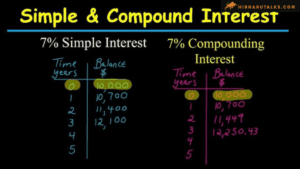
Bonds and Compound Interest: A Safe Path to Wealth
Contents
- 1 Compound Interest
- 1.1 Bonds and Compound Interest: A Safe Path to Wealth
- 1.1.1 Understanding Bonds
- 1.1.2 The Mechanics of Compound Interest
- 1.1.3 The Synergy Between Bonds and Compound Interest
- 1.1.4 Wealth Building Strategies with Bonds and Compound Interest
- 1.1.5 The Benefits of Bonds and Compound Interest
- 1.1.6 Potential Drawbacks to Consider
- 1.1.7 Conclusion
- 1.1.8 FAQs:
- 1.1.8.1 1.What are bonds?
- 1.1.8.2 2.How does compound interest work?
- 1.1.8.3 3.What are the different types of bonds?
- 1.1.8.4 4.How can I benefit from compound interest with bonds?
- 1.1.8.5 5.What is bond laddering?
- 1.1.8.6 6.Are bonds a safe investment?
- 1.1.8.7 7.What are the tax implications of bonds?
- 1.1.8.8 8.Can I lose money in bonds?
- 1.1.8.9 9.How do I start investing in bonds?
- 1.1.8.10 10.What should I consider before investing in bonds?
- 1.2 Compound Interest
- 1.3 Mazagon Dock Shipbuilders Reports Impressive 75.7% YoY Net Profit Growth in Q2 FY25
- 1.1 Bonds and Compound Interest: A Safe Path to Wealth
Compound Interest
Bonds and Compound Interest: A Safe Path to Wealth
In the realm of personal finance, the quest for wealth often leads individuals to explore various investment avenues. Among these, bonds and compound interest stand out as two of the safest and most effective methods for building wealth over time. This blog will delve into how these financial instruments work together, offering a reliable pathway to secure your financial future.
Understanding Bonds
Bonds are fixed-income securities that represent a loan made by an investor to a borrower, typically corporate or governmental. When you purchase a bond, you are essentially lending money to the issuer in exchange for periodic interest payments and the return of the bond’s face value at maturity.


Types of Bonds
- Government Bonds: Issued by national governments and considered low-risk.
- Corporate Bonds: Issued by companies; these can offer higher returns but come with increased risk.
- Municipal Bonds: Issued by local governments, often providing tax benefits to investors.
The Mechanics of Compound Interest
Compound interest refers to the interest on a loan or deposit calculated based on both the initial principal and the accumulated interest from previous periods. This means that interest earned also earns interest, which can significantly enhance your investment over time.
How Compound Interest Works
- Principal Amount: The initial sum of money invested.
- Interest Rate: The percentage at which the investment grows annually.
- Time Period: The duration for which the investment is held.
- Compounding Frequency: How often the accumulated interest is added to the principal (e.g., annually, semi-annually, quarterly).
The formula for calculating compound interest is:
A=P(1+rn)ntA = P \left(1 + \frac{r}{n}\right)^{nt}
Where:
- AA = the amount of money accumulated after n years, including interest.
- PP = the principal amount (the initial investment).
- rr = the annual interest rate (decimal).
- nn = the number of times that interest is compounded per year.
- tt = the number of years the money is invested or borrowed.


The Synergy Between Bonds and Compound Interest
When bonds are combined with the power of compound interest, investors can maximize their returns while minimizing risk. Here’s how this synergy works:
- Stable Income: Bonds provide regular interest payments, which can be reinvested to earn compound interest.
- Predictable Growth: The fixed interest rates of bonds create a predictable growth pattern, making it easier to project future earnings.
- Risk Mitigation: Bonds, particularly government bonds, are considered safer than stocks, offering a stable investment environment.
Wealth Building Strategies with Bonds and Compound Interest
1. Reinvesting Interest Payments
Investors can choose to reinvest their bond interest payments. By doing so, they not only receive periodic income but also capitalize on compound interest, leading to greater wealth accumulation over time.
2. Laddering Bonds
Bond laddering involves purchasing bonds with varying maturities. This strategy helps mitigate interest rate risk and provides regular access to cash flow, which can be reinvested to take advantage of compounding.
3. Using Bond Funds
Investing in bond funds allows for diversification within the bond market. These funds typically reinvest income back into the fund, creating an effect similar to compounding and providing investors with a broader exposure to different types of bonds.
4. Setting Long-Term Goals
To effectively use bonds and compound interest as wealth-building tools, investors should set clear, long-term financial goals. This approach allows for a better understanding of how much to invest and the expected returns over time.
The Benefits of Bonds and Compound Interest
- Low Risk: Bonds, especially government securities, offer a safer investment option.
- Consistent Returns: Bonds provide regular interest payments, creating a reliable income stream.
- Inflation Protection: Certain bonds, like Treasury Inflation-Protected Securities (TIPS), adjust for inflation, preserving purchasing power.
- Tax Advantages: Many municipal bonds are exempt from federal and state taxes, enhancing after-tax returns.
Potential Drawbacks to Consider
While bonds and compound interest are effective for wealth building, there are some drawbacks to consider:
- Lower Returns: Compared to stocks, bonds typically offer lower returns, which may not keep pace with inflation.
- Interest Rate Risk: If interest rates rise, bond prices tend to fall, potentially leading to capital losses.
- Opportunity Cost: Investing heavily in bonds may limit exposure to higher-growth investments.
Conclusion
Bonds combined with the power of compound interest offer a secure and effective path to wealth. By understanding how these financial instruments work and strategically leveraging their benefits, investors can build a robust financial future. Whether through reinvesting interest payments, employing bond laddering strategies, or investing in bond funds, the synergy between bonds and compound interest provides a framework for achieving long-term financial goals.
FAQs:
1.What are bonds?
A. Bonds are fixed-income securities representing a loan from the investor to the issuer, typically offering periodic interest payments.
2.How does compound interest work?
A. Compound interest is the interest calculated on the initial principal and the accumulated interest from previous periods, leading to exponential growth.
3.What are the different types of bonds?
A. The main types include government bonds, corporate bonds, and municipal bonds, each with varying levels of risk and return.
4.How can I benefit from compound interest with bonds?
A. By reinvesting interest payments from bonds, investors can take advantage of compound interest to enhance overall returns.
5.What is bond laddering?
A. Bond laddering is a strategy where investors purchase bonds with different maturities to manage interest rate risk and ensure regular cash flow.
6.Are bonds a safe investment?
A. Generally, bonds are considered safer than stocks, especially government bonds, but they still carry some risk.
7.What are the tax implications of bonds?
A. Many municipal bonds offer tax advantages, including exemptions from federal and state taxes, enhancing after-tax returns.
8.Can I lose money in bonds?
A. Yes, if interest rates rise significantly, bond prices can fall, leading to potential capital losses.
9.How do I start investing in bonds?
A. You can start by purchasing individual bonds through a broker or investing in bond funds for diversified exposure.
10.What should I consider before investing in bonds?
A. Assess your risk tolerance, investment goals, and the current interest rate environment before investing in bonds.
Compound Interest
Mazagon Dock Shipbuilders Reports Impressive 75.7% YoY Net Profit Growth in Q2 FY25





















1 comment